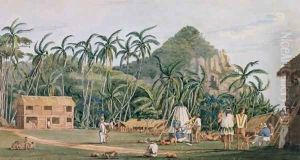Admiral William Henry Smyth Paintings
Admiral William Henry Smyth was an English naval officer, hydrographer, and astronomer who made significant contributions to the Royal Navy and the scientific community of his time. Born on January 21, 1788, in Westminster, London, Smyth was the son of American loyalist Thomas Smyth. He joined the Royal Navy in 1804, at the age of 14, and served during the Napoleonic Wars. Smyth quickly rose through the ranks, participating in notable naval engagements.
After the war, Smyth's interests turned to science and exploration. He undertook a survey of the Mediterranean Sea, which resulted in the publication of the 'Memoir Descriptive of the Resources, Inhabitants, and Hydrography, of Sicily and Its Islands, Interspersed With Antiquarian and Other Notices' (1824). This work established his reputation as a skilled hydrographer. Smyth continued to produce charts and sailing directions that were invaluable to navigation in the Mediterranean.
In addition to his hydrographic work, Smyth was an avid astronomer. He built a private observatory at his home in Bedfordshire, England, where he cataloged double stars and nebulae. His most significant astronomical work, 'Cycle of Celestial Objects' (1844), earned him the Gold Medal of the Royal Astronomical Society in 1845. This two-volume work, also known as the 'Bedford Catalogue,' included observations of a multitude of celestial objects and served as an essential reference for astronomers.
Smyth's contributions to the field of astronomy extended beyond his own observations. He was actively involved in the scientific community, serving as President of the Royal Astronomical Society and as a founding member of the Royal Geographical Society. His work in both hydrography and astronomy reflected his broad interests and his dedication to advancing knowledge in these fields.
Admiral William Henry Smyth passed away on September 8, 1865, in St John's Lodge, near Aylesbury, Buckinghamshire, England. His legacy is preserved through the numerous charts and publications that remain valuable to both sailors and astronomers. His interdisciplinary approach to science and exploration exemplifies the spirit of inquiry and discovery that characterized the 19th century.
